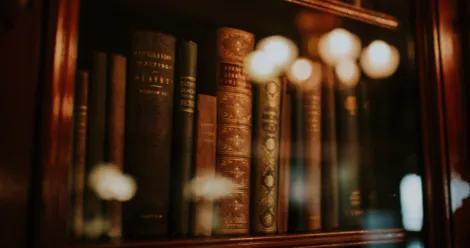
Who Jane Read, Who Read Jane: Austen’s Readers and Favorite Books
This content contains affiliate links. When you buy through these links, we may earn an affiliate commission.
We’re celebrating Jane Austen on this, the day of her death, with a bevy of posts about her work and legacy. See all the posts here.
I’ve been studying the evolution of the bookworm. Although it’s hard to imagine, we bookworms haven’t always existed. There were reading addicts before books because scribes and monks loved words in the same way we do, but it took books and literacy to create a society where bookworms thrive. My interest in rabid readers got started years ago with The Information by James Gleick. This year I’ve been focusing on the nineteenth century when novel reading reached a kind of critical mass. Because 2017 is the 200th anniversary of Jane Austen’s death, I thought I’d research who Jane loved to read, and who might have loved reading Miss Austen before she died. Jane Austen’s decade was the 1810s. She published four books while living, two were published the year of her death. All six came out during 1811-1817. She wasn’t a bestseller in her day, but she got a reasonable amount of praise and made a respectable amount of money. Her books were published anonymously. Sense and Sensibility by a Lady. Pride and Prejudice by the author of Sense and Sensibility, and so on. Books were very expensive in her day. Authors and their fandoms were microscopic compared to the gigantic fame writers achieve today. Reading Women in the English Novel 1800-1900 by Merryn Williams and Dickens’ Fur Coat and Charlotte’s Unanswered Letters by Daniel Pool gave me a slight sense of how author fandoms evolved in the nineteenth century. Wildly popular novels did exist before 1800 like Robinson Crusoe and Gulliver’s Travels, but just how widely read were they in a society where the majority couldn’t afford books and were illiterate. Ironically, it was a time when girls weren’t educated, many of the novelists were women, and most of the readers might have been female. Because Jane Austen essentially owns the early nineteenth-century English novel I thought I’d start with her in my quest to understand the beginning of popular writers and their fans. Jane is not the big bang of novel reading, but she was part of the inflationary period of our early reading universe. In fact, studying what Jane read suggests a much more happening reading era in the 1700s. That surprised me because few books from that century are read for fun today. I’m amazed how much has been written about a woman who left so little biographical evidence. If only Goodreads and WordPress existed back then and we had Jane’s own words telling us what she loved about reading and what she knew about her fans. Who Jane Read Jane Austen read widely in the classics of her day, including the famous, Shakespeare and Milton, and the forgotten. Here are some of the popular books she probably read. The year given is the date of publication, not when Jane read those books. An asterisk denotes known favorites. Remember Jane lived from 1775-1817 and published between 1811-1817. Links are to free online editions.
I’ve been studying the evolution of the bookworm. Although it’s hard to imagine, we bookworms haven’t always existed. There were reading addicts before books because scribes and monks loved words in the same way we do, but it took books and literacy to create a society where bookworms thrive. My interest in rabid readers got started years ago with The Information by James Gleick. This year I’ve been focusing on the nineteenth century when novel reading reached a kind of critical mass. Because 2017 is the 200th anniversary of Jane Austen’s death, I thought I’d research who Jane loved to read, and who might have loved reading Miss Austen before she died. Jane Austen’s decade was the 1810s. She published four books while living, two were published the year of her death. All six came out during 1811-1817. She wasn’t a bestseller in her day, but she got a reasonable amount of praise and made a respectable amount of money. Her books were published anonymously. Sense and Sensibility by a Lady. Pride and Prejudice by the author of Sense and Sensibility, and so on. Books were very expensive in her day. Authors and their fandoms were microscopic compared to the gigantic fame writers achieve today. Reading Women in the English Novel 1800-1900 by Merryn Williams and Dickens’ Fur Coat and Charlotte’s Unanswered Letters by Daniel Pool gave me a slight sense of how author fandoms evolved in the nineteenth century. Wildly popular novels did exist before 1800 like Robinson Crusoe and Gulliver’s Travels, but just how widely read were they in a society where the majority couldn’t afford books and were illiterate. Ironically, it was a time when girls weren’t educated, many of the novelists were women, and most of the readers might have been female. Because Jane Austen essentially owns the early nineteenth-century English novel I thought I’d start with her in my quest to understand the beginning of popular writers and their fans. Jane is not the big bang of novel reading, but she was part of the inflationary period of our early reading universe. In fact, studying what Jane read suggests a much more happening reading era in the 1700s. That surprised me because few books from that century are read for fun today. I’m amazed how much has been written about a woman who left so little biographical evidence. If only Goodreads and WordPress existed back then and we had Jane’s own words telling us what she loved about reading and what she knew about her fans. Who Jane Read Jane Austen read widely in the classics of her day, including the famous, Shakespeare and Milton, and the forgotten. Here are some of the popular books she probably read. The year given is the date of publication, not when Jane read those books. An asterisk denotes known favorites. Remember Jane lived from 1775-1817 and published between 1811-1817. Links are to free online editions.
- 1752 – Female Quixote by Charlotte Lennon
- 1753 – The History of Sir Charles Grandison by Samuel Richardson*
- 1778 – Evelina by Frances Burney
- Jane Austen: What books were on her reading list?
- Jane Austen’s Reading: The Chawton Years
- Allusions to Books and Authors in Jane Austen’s writings (most complete list)
- Jane Austen: A Life by Claire Tomalin
- The Real Jane Austen: A Life in Small Things by Paula Byrne
- Jane Austen for Dummies by Joan Klingel Ray
- What Jane Austen Ate and Charles Dickens Knew by Daniel Pool
- Blame Jane Austen for My Fanfiction Addiction
- 5 Contemporary YA Jane Austen Retellings
- Get Lost in Austen: 13 Adaptations for Jane Austen Fans
- Why EMMA is the Worst Jane Austen Novel
- 5 Excellent Jane Austen Comic Book Adaptations
- Giveaway: Jane Austen Penguin Clothbound Editions!
- From Pemberley to Trump Tower: Jane Austen Quotes Meet Trump Tweets
- The Queerness of Emma
- Literary Tourism: Jane Austen-Themed Destinations
- Don’t Dismiss Jane Austen as a Writer of “Silly Things”











